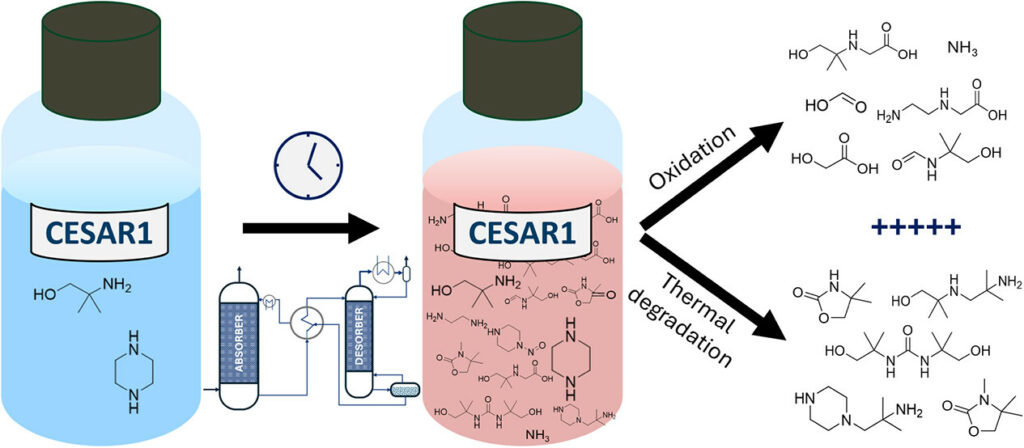
01.09.2025
New Study Reveals What Happens to CESAR1 During CO₂ Capture
A recent scientific study provides new insights into how the promising CO2 capture solvent CESAR1 degrades under industrially relevant conditions.

CESAR1, a blend of 2-amino-2-methylpropanol (AMP) and piperazine (PZ), was originally developed in the EU project CESAR and has since been widely tested, including at the Technology Centre Mongstad (TCM). It has shown strong performance with lower energy use and higher stability than traditional benchmark solvents such as monoethanolamine (MEA).
The study, led by Vanja Bruvik from SINTEF, investigated degradation pathways of CESAR1 under oxidative and thermal stress. Using advanced liquid chromatography and mass spectrometry, the researchers identified and quantified 48 different degradation compounds, including 15 that had not previously been reported for AMP, PZ, or CESAR1.
Investigating How CESAR1 Breaks Down
One key finding is that CESAR1 degrades more rapidly than its individual components, with oxidative degradation proving to be the most critical factor. Compounds such as formic acid, formaldehyde, and N-nitrosopiperazine were detected under oxidizing conditions, while several other degradation products were formed at elevated temperatures. Importantly, some degradation pathways observed in laboratory tests correspond closely to results from pilot-scale operation at TCM, strengthening the relevance of the findings for industrial application.
“Understanding how solvents change over time is essential for safe, cost-effective, and environmentally sound CO2 capture. Our work provides important knowledge that can be used to optimize solvent management strategies, including how to monitor degradation and when to carry out solvent reclamation.”
Vanja Bruvik, Research Scientist at SINTEFFrom Laboratory to Large-Scale Testing
At TCM, CESAR1 has been tested extensively under real flue gas conditions, and the new results contribute directly to ongoing projects focused on emission monitoring and solvent stability.
“By combining laboratory research with large-scale testing, we build the knowledge base needed to ensure that next-generation solvents like CESAR1 can be deployed at full scale.”
Karen Karolina Høisæter, Senior Research Scientist at TCMAs the global need for CO2 capture grows, studies like this help pave the way for more robust and sustainable technologies that can play a crucial role in reaching climate targets.
